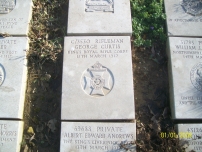| First Name: | George | Last Name: | CURTIS | |
|---|---|---|---|---|
| Date of Death: | 27/12/1917 | Lived/Born In: | Stroud Green | |
| Rank: | Private | Unit: | London2/13 | |
| Memorial Site: | ||||
Current Information:Age-23 129, Stapleton Hall Road, Stroud Green Jerusalem War Cemetery
After the Western Front, the second largest theatre of war between 1914 and 1918 was Egypt and Palestine. Britain had long had a foothold in Egypt guarding the vitally important Suez Canal and when war was declared against Turkey (the Ottoman Empire) who controlled all of what is now known as the Middle East, British troops were sent to guard the canal from attacks from the north. For the first two years of the war the British forces were on the defensive as the Turks, backed by the Germans, made a number of attempts against the canal but an important victory in August 1916 at Rumani relieved the pressure and the British force was then able to move onto the offensive and advance north into Palestine. There followed the First and Second Battles of Gaza in March and in April, 1917 in which the British tried but failed to break through the Turkish line that stretched from the coast at Gaza across the desert to Beersheba and it was not until November of 1917, in the Third Battle of Gaza that Turkish resistance here was broken. The following month saw the capture of Jerusalem after which the Egyptian Expeditionary Force continued their thrust northwards, capturing more and more Arab territory. But it was not all plain sailing. The Turks were determined fighters and put up a stout resistance. British intelligence had discovered that the enemy were planning a desperate attack to recover Jerusalem. This was launched at 1.30am on 27th December, astride the Nablus road where the country is very broken and the roads extremely winding. The main attack fell on 179 Brigade of 60th (London) Division and began when a forward post of 2/13th London, half a mile in front of the line, fell back at midnight to report it had been in contact with the enemy. This was followed at 1.45am when an outpost company of 2/16th London was driven off Kh. Ras el Tawil, east of the road after which the general attack developed. Rushing forward, hurling bombs, the Turks put two machine-guns out of action on the right of 2/13th London’s front and made a lodgement in their position but a counter attack soon drove them out. Elsewhere on 179 Brigade’s front the attacks were repulsed by rifle and machine-gun fire, assisted by an artillery barrage which responded very quickly to the red distress rockets. There followed a Turkish artillery bombardment which fell particularly heavily on Teel el Ful, east of the Nablus road, and on the Kh. Adase ridge to the north-east. At 3.30am a Turkish infantry attack was repelled but at 5.30am, a stronger attack broke into 2/16th London’s line and the enemy reached the lower slopes of Tell el Ful. However they did not capture the dominating heights which was just as well because it gave a commanding view of Jerusalem. From these lower slopes, the Turks enfiladed 2/13th London’s line and forced them to withdraw 200 yards. A company of 2/15th London was sent in platoon by platoon to strengthen the line and another company was sent to 2/16th London. From here they counter-attacked the Turkish right flank, temporarily dislodging him, but were then forced to withdraw after suffering heavy casualties. At 1pm the enemy launched another attack on 2/13th London but were driven off by that battalion and the attached company of 2/15th London. The Turkish attack had failed but it had been a hard day of fighting with many casualties suffered by 179 Brigade. One of these was George Curtis of 2/13th London who was killed in action. |
||||
| « Back to Search Results | ||||
| If you think any of the information shown here is incorrect, Click Here to submit your amends and comments | ||||




